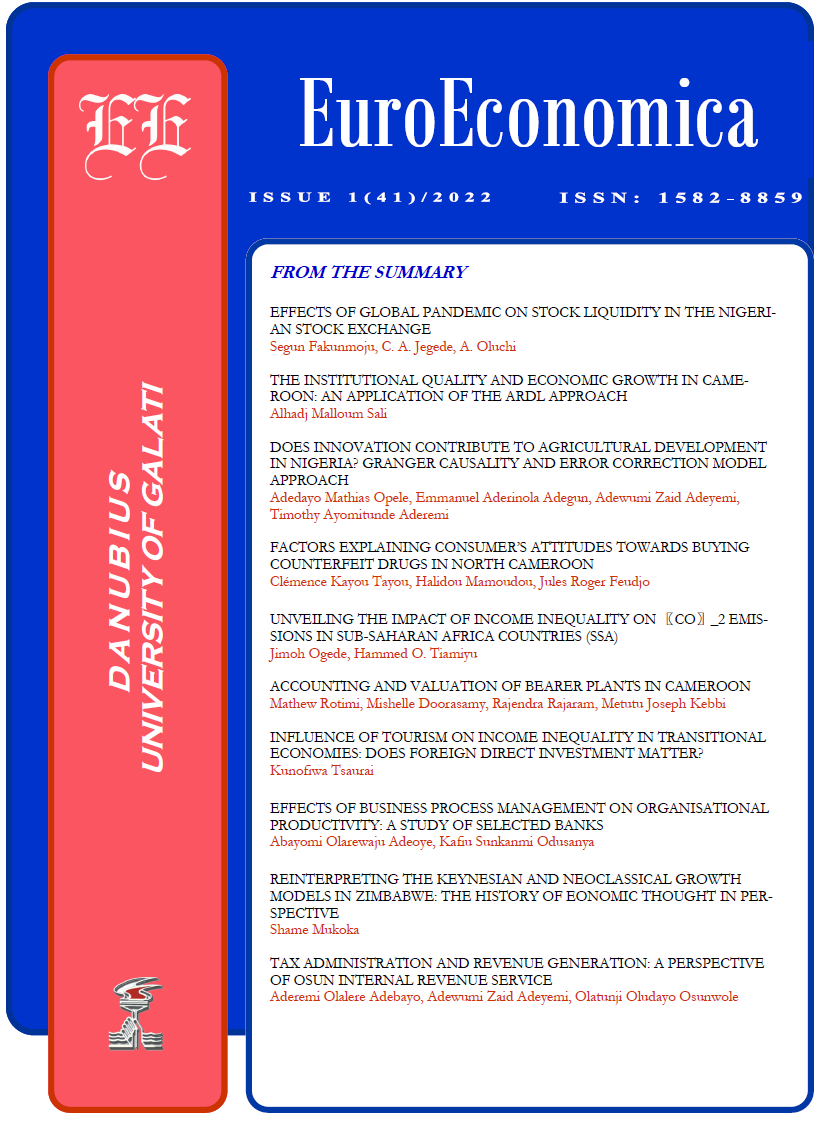Does female unemployment increase crime ? Evidence in selected Sub-Saharan African countries
Keywords:
Female unemployment, crime, non-parametric, parametric methodsAbstract
A large body of theorical and empirical researches suggest that unemployment has a positive and significant effect on crime. Contrary to this finding, some studies conclude that unemployment has a negative effect on crime. There further revealed that there is mixed relationship between unemployment and crime. In this context, this paper examines the direct effect of female unemployment on crime in a sample of 40 Sub-Saharan African countries over the period 1990-2020. Using non-parametric and parametric methods. The paper disclosed a positive relationship between female unemployment and crime. The econometric analysis suggests that a higher level of female unemployment increase crime.
References
Ayang, E., Timbi, S. & Toumpiguim, M. D. (2021). Effects of Unemployment on Crime in selected Sub-Sahara African Countries. International Journal of Scientific Research and Management, 09(02), 2021-2061.
Becker, G. (1968). Crime and Punishment: An Economic Approach. Journal of Political Economy, 76(2), 169–217.
Box, S. (1987). A recession, crime and punishment, London: Macmillan.
Cantor, D. & Land, K. (1985). Unemployment and crime rates in the post-World War Two United States. American sociological review, 50(3), 317-332
Carmichael, F. & Ward, R. (2001). Male unemployment and crime in England and Wales. Economics Letters, 73(1), 111-115
Carmignani, F. & Avom, D. (2010). The Social Development Effects of Primary Commodity Export Dependence. Ecological Economics, 70(2), 317-330.
Cezary, A. K., Braithwaite, J. & Chapman, B. (1998). Unemployment and Crime: Toward Resolving the Paradox. Journal of Quantitative criminology. 14(3), 215-242.
Cleveland, W.S. (1994). The Elements of Graphing Data. Hobart Press, NJ.
Ehrlich, I. (1973). Participation in Illegitimate Activities: a Theoretical and Empirical Investigation. Journal of Political Economy, 81(3), 521–565.
Fajnzylber, P., Lederman, D. & Loayza, N. (2002). Inequality and violent crime. J. Law Econ., 45(1), 1–41.
Fallahi, F. & Rodriguez, G. (2007). Using Markov-Switching Models to Identify the Link between Unemployment and Criminality. Working Papers 0701E, University of Ottawa, Department of Economics.
Greenberg, D. F. (2001). Time series analysis and crime rates. J. Quant. Criminol. 17(4), 291-32
Hamzah, S. N. Z. & Lau, E. (2013). The role of social factors in explaining crime. MPRA Pager 43518
Imrohoroglu, A., Merlo, A. & Rupert, P. (2001). What Accounts for the Decline in Crime?. Penn Institute for Economic Research Department of Economics University of Pennsylvania Working Paper No. 01-01
Jongman, R. W. (1983). Chômage et (puis?) Crime/ Unemployment and (then?) Crime. Déviance et société/ Deviance and society, 7(4), 339-346; doi: 10.3406/ds. 1983. 1386
Lee, D. Y. & Holoviak, S. J. (2006). Unemployment and crime: An empirical investigation. Applied Economics Letters, 13(2), 805-810.
Nourou, M. (2014). Foreign aid and development: looking beyond the growth effect. Journal of Economic Development, 39(4), 99-115.
Raphael, S., & Winter-Ebmer, R. (2001). Identifying the effect of unemployment on crime. The Journal of Law and Economics, 44(1), 259 283.
Sachsida, A., de Mendonça, M. J. C., Loureiro, P. R. & Gutierrez, M. B. S. (2010). Inequality and criminality revisited: Further evidence from Brazil. Empirical Economics, 39(1), 93 109.
Smriti, S. (2015). Caste-based crimes and economic status: Evidence from India. Journal of Comparative Economics, 43(1), 204-226.
Vaillant, N. G. & Dervaux, B. (2011). La dissuasion des homicides volontaires: Une analyse économétrique sur données de panel françaises/ Deterrence of voluntary homicides: An econometric analysis on French panel data. Revue Economique Economic Journal, 62(2), 237-254.
Witt, R., Clarke, A. & Fielding, N. (1998). Crime, earnings inequality and unemployment in England and Wales. Applied Economics Letters, 5(4), 265-67.
World Bank (2020). World development indicators. https://databank.worldbank.org/data/source/world-development-indicators#.
Downloads
Published
How to Cite
Issue
Section
License
Copyright (c) 2022 Eric Ayang, Christel MELA , Derrick FOSSONG

This work is licensed under a Creative Commons Attribution-NonCommercial 4.0 International License.
The author fully assumes the content originality and the holograph signature makes him responsible in case of trial.


